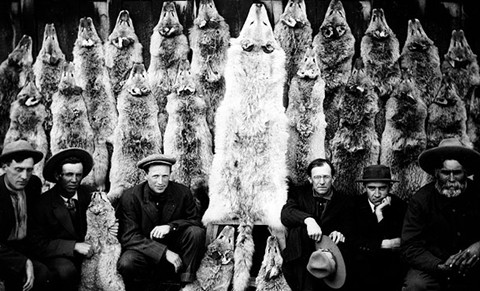
Legal wolf hunting has finally returned to the Lower 48, ostensibly as a way to control the species’ population while also earning Idaho’s state government a few bucks. The program obviously has some folks in a lather, as history shows that rapacious hunting was responsible for the gray wolf‘s longtime residency on the endangered species list. And that hunting was egged on by publicly funded bounties, which paid a tidy sum in exchange for each lupine scalp.
But, rather ironically, the gray wolf might have vanished entirely if not for the hunters’ use of cost-benefit analysis. As early as 1881, it seems, many hunters figured out that it was more cost effective to raise wolves in captivity and then kill them than it was to go out in the wild. That’s largely because the bounties were miscalibrated, or offered by too many separate tiers of government. This 1902 article (PDF) from Nebraska explains the scam:
The large number of claims coming into the State Auditor’s office for bounties on wolves and coyotes has led that official to make an investigation, and he has arrived at the conclusion that the farmers and ranchers in the western part of the State have gone into the business of breeding these animals for the bounty market. In one instance it was found that one farmer had raised more than 100 wolves last Summer from several animals he had trapped and penned up for that purpose.
The State law authorizes the County Clerk to pay $3 from the county fund for each coyote or wolf scalp presented, and he certifies the fact of payment to the Auditor, who pays $1 additional, making $4 for each wolf or coyote. The State Auditor declares that this pays better than hog raising, and naturally the farmers have turned their attention to this industry.
Four bucks in 1902 is equivalent to roughly $95 in today’s dollars. Had the government been more stingy, the wolf breeding would have been less profitable, and the species probably would have been hunted to extinction before it could be declared endangered in 1973. Which actually makes us rather grateful that the public servants of yore weren’t too good at structuring incentives.
(Image via PBS)


citizen (world) // Sep 3, 2009 at 1:17 pm
This will be an interesting hunting season for Eastern Wa and the Idaho Panhandle. The assumption is that this season will not be a wolf slaughter as the number of wolves is still low, they still tend to be in pretty remote areas, and being limited to hunting from the ground will make them extremely difficult to target. So, this may be a case of a few thousand permits being issued and very few actual wolves getting shot. As I say, we’ll see.
Brendan I. Koerner // Sep 3, 2009 at 1:24 pm
Excellent point. It’s been so long since there was a wolf hunt out that way, so I’m not sure anyone really remembers the challenges. My takeaway from the historical research is that wolves are relatively tough to hunt, which is why so many folks opted for the breeding method instead.
On the other hand, I wonder how new technology will affect the hunters’ chances. We’ll see, indeed.